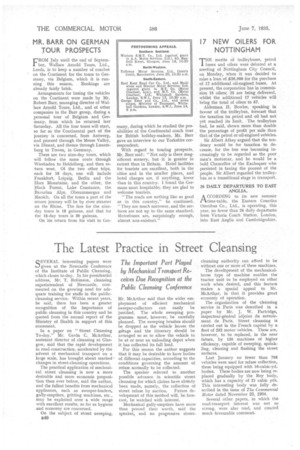The Latest Practice in Street Cleansing
Page 54

If you've noticed an error in this article please click here to report it so we can fix it.
The Important Part Played by Mechanical Transport Re-, ceives Due Recognition at the Public Cleansing Conference
SEVERAL interesting papers were given at the Newcastle Conference of the Institute of Public Cleansing, which closes to-day. In his presidential address, Mr. T. Robinson, cleansing superintendent of Newcastle, commented on the growing need for adequate training for staffs in the publiccleansing service. Within recent years, he said, there has been a greater recognition of the importance of public cleansing in this country and he quoted from the annual report of the Ministry of Health in support of this statement.
In a paper on " Street Cleansing To-day," Mr. Gavin C. McArthur, assistant director of cleansing at Glasgow, said that the rapid development in road construction, accelerated by the advent of mechanical transport on a large scale, has brought about marked . changes in street-cleansing operations.
The practical application of mechanical street cleansing is now a more desirable and more economic proposition than ever before, said the author, and the fullest benefits from mechanical appliances, such as sweeper-loaders, gully-emptiers, gritting machines, etc., may be exploited over a wide range with excellent results, so far as hygiene and economy are concerned.
On the subject of street sweeping, MO
Mr. McArthur said that the wider employment of efficient mechanical sweeper-collectors can easily be justified. The whole sweeping programme must, however, be carefully planned. The sweeping brushes should be dropped as the vehicle leaves the garage and the itinerary should be arranged so as to allow the vehicle to be at or near an unloading depot when it has collected its full load.
For this reason the author suggests that it may he desirable to have bodies of different capacities, according to the conditions governing the amount of refuse normally to be collected.
The speaker referred to another possible advance in scientific street cleansing for which claims have already been made, namely, the collection of
street refuse by suction. Future development of this method will, he forecast, be watched with interest.
Mechanical gully-emptiers have more than proved their worth, said the speaker, and no progressive street
cleansing authority can afford to be without one or more of these machines.
The develbpment of -the mechanicalhorse type of machine enables the tractor unit to be employed on other work when desired, and this feature makes a special appeal to Mr. McArthur, in that it provides great economy of operation.
The organization of the cleansing service in Paris was described in a paper by Mr. J. W. Partridge. inspecteur-general adjoint du nettoiement de Paris. Street cleansing is carried out in the French capital by a fleet of 252 motor vehicles. These are, however, to be replaced, in the near future, by 130 machines of higher efficiency, capable of sweeping, sprinkling, cleaning and flushing the street surfaces.
Last January no fewer than 795 vehicles were used for refuse collection, these being equipped with 16-cubic-yd. bodies. These bodies are now being replaced gradually by the Rey body, which has a capacity of 21 cubic yds. This interesting body was fully described in the issue of The Commercial Motor dated November 23, 1934.
Several other papers, in which the road-transport interest was not so strong, were also read, and created much favourable comment.




























































































